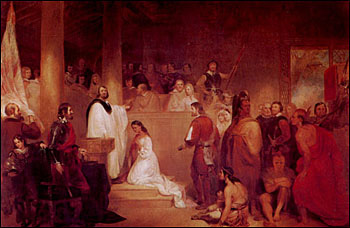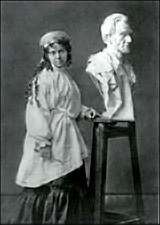By Danielle Scull, USCHS Intern
As visitors wander the halls of the U.S. Capitol, many are awed by the architecture of the building and the diverse artwork featured on its walls. Upon closer examination visitors can learn about the role women have played in our nation’s history through the sculpture, murals, and portraiture.
By an Act of Congress in July 1864, each state was invited to present two statues of citizens worthy of national recognition. Five states have chosen to honor a woman with one of their statue selections. Esther Hobart Morris (WY-Statuary Hall) was a woman’s suffragist, a judge who never had a decision reversed in a higher court, and the first woman justice of the peace. Colorado honored Dr. Florence Rena Sabin (CO-Statuary Hall) for her work as a distinguished teacher, scientist, humanitarian and writer. One of the first female professors in the United States, Maria L. Sanford (MN-Senate corridor) was a celebrated orator and educator. Frances E. Willard (IL-Statuary Hall), an educator influential in social and economic reform, was the founder and president of the Women’s Christian Temperance Union. The most recent statue is of Congresswoman Jeanette Rankin (R-MT), located in the Hall of Columns. Ms. Rankin was the first woman elected to the House of Representatives in 1917, two years before women gained the right to vote. Though well known for her votes against entering into WWI and WWII, more importantly, Rankin was a pioneer for the women’s movement.
Other examples of statues that feature women include neoclassical representations of women symbolizing Liberty, Justice, Freedom, History, Peace, Hope and America. Based on Roman and Greek mythology, these idealized figures embody the ideals of the American government. The statue of Justice, for example, in the Old Supreme Court Chamber, is based on Themis, the Greek Goddess of Justice, and the Car of History, above the north entrance to Statuary Hall, represents Clio, the Greek Muse of History. Crafted in marble and plaster, the sculptures are scattered throughout the interior and exterior of the Capitol building.
Perhaps the most prominent sculpture depicting women in the Capitol is the Portrait Monument to Lucretia Mott, Elizabeth Cady Stanton, and Susan B. Anthony. Located in the Capitol Rotunda, this piece was added to the Capitol collection in 1921 as a gift from the National Women’s Party. Designed by Adelaide Johnson (1846-1955) as a tribute to the passage of the 19th Amendment, this 7’x5’8”x5′ marble sculpture features a bust of each woman and weighs exactly seven tons.
In addition to the marble and bronze statues, there are many women depicted in mural paintings throughout the Capitol. On the House side are three Allyn Cox paintings that feature important women in American History. In the Hall of Capitols, several nurses are shown attending Civil War casualties in the Capitol, while in Great Experiment Hall, paintings portray Jeanette Rankin working as a pacifist and Anna Howard Shaw and Carrie Chapman Catt participating in a women’s suffrage parade. In the House Appropriations Committee room (H-143), a painting by H. Lyman Sayen, Good Government, features a central figure of a woman surrounded by several women involved in domestic activities. It is meant to convey the peaceful conditions of the United States’ administration. On the first floor of the Senate wing, above the Hugh Scott Room (S-120), a mural painted by Charles Schmidt features the seven member crew of the ill-fated space shuttle Challenger, including astronaut Judy Resnik and teacher Christa McAulliffe. Also on the Senate side are portraits of Pocahontas and Senator Hattie W. Caraway (D-AK).

The Rotunda of the Capitol features women in a variety of ways. The eight paintings circling the Rotunda walls convey the early history of America, from exploration and discovery to the American Revolution. Women are shown as active participants of history in several of the paintings, including the Baptism of Pocahontas, The Embarkation of the Pilgrims at Delft Haven, Holland, July 22nd, 1620, and General George Washington Resigning His Commission to Congress as Commander in Chief of the Army at Annapolis, Maryland, December 23d, 1783. Perhaps the most obvious depiction of women in the Rotunda is the fresco painting in the canopy of the dome, the Apotheosis of George Washington, by Constantino Brumidi, completed in 1865. This allegorical painting, combining mythological and historical figures, features George Washington, seated in majesty, with Liberty on his right. Surrounding Washington are thirteen maidens symbolizing the original States. The border is composed of six allegorical groupings which feature among others, Freedom and Minerva (Goddess of Wisdom).

In addition to art depicting women and their contributions to the nation, there are a number of works created by women artists. Marisol Escobar (1930-) created the bronze statue of Father Damien (HI-Statuary Hall), the missionary from Hawaii, displayed in the Hall of Columns. Jimilu Mason (1930-) sculpted the busts of Constantino Brumidi, located in the Brumidi corridor, and Vice President Lyndon B. Johnson, located in the Senate Wing second floor. Vinnie Ream (1847-1914) is well known for her statue of President Abraham Lincoln, located in the rotunda. At age 17, Vinnie Ream, a shy young woman, very much wanted to sketch President Lincoln. Though reluctant at first, Lincoln agreed when he learned that Ream was poor. During theast five months of Lincoln’s life, Ream followed the President, creating sketches of him in action. These sketches were then used as the basis for her famous statue of the President. Ream also sculpted the statue of Sequoyah (OK-Statuary Hall), the inventor of the Cherokee alphabet, and Samuel J. Kirkwood (IA-Statuary Hall), a Senator and Secretary of the Interior; both statues are located in Statuary Hall.
Much like the Capitol, the work of its female artists is done in a variety of mediums. Maria Herndl (1860-1912) worked in glass to create the skylights in the Senate Press Gallery and the George Washington Memorial Window in the Senate dining room. Esther Edmonds (1888-1976), Ellen Day Hale (1855-1940), E. Sophonisba Hergesheimer (1873-?), Rebecca Polk (1858-?) and Lucy M. Stanton (1875-1931) all have oil paintings of Speakers of the House featured in the Speaker’s Lobby. In total there are forty-nine women artists whose work is displayed in the Capitol building.
This exploration provides an introduction to the vast amount of artwork in the Capitol both created by, and portraying, women. The Capitol is a symbol of our nation’s history and whether women are the focus, creators, or onlookers in various scenes, the artwork conveys the importance of women’s contributions to American society. The Statue of Freedom, atop the Capitol Dome, serves as a constant reminder of this important, but sometimes overlooked, fact.
Originally Published: 1999


